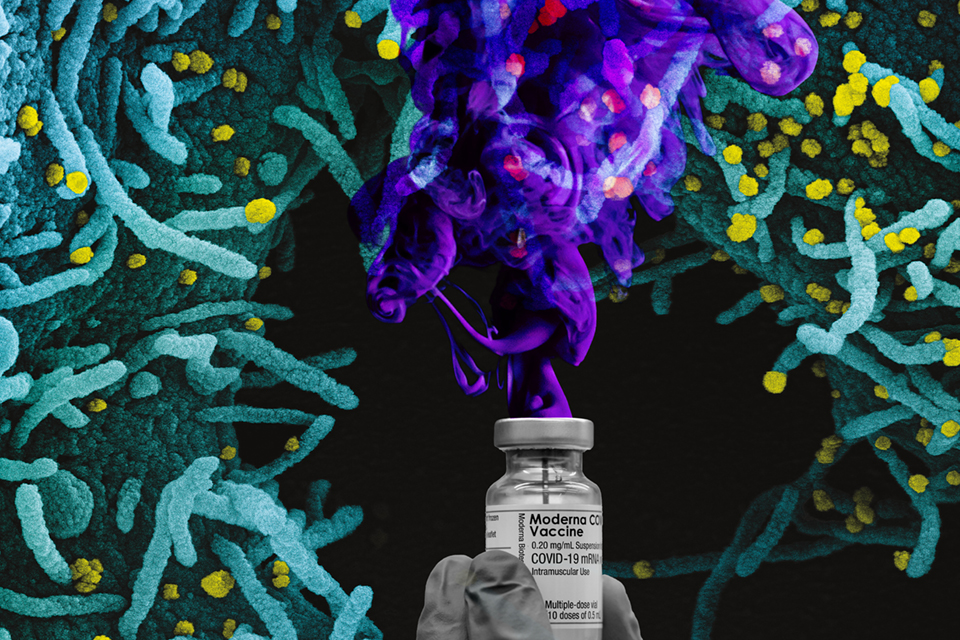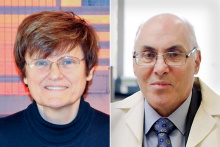The path to a COVID-19 vaccine
The winners of the Rosenstiel Award tell the story of how their research led to two of the vaccines now being given to millions of people around the world.
 Collage by Jessica Tanny
Collage by Jessica TannyThis year’s Lewis S. Rosenstiel Award for Distinguished Work in Basic Medical Research was awarded to two pioneering scientists whose research underlies two of the COVID-19 vaccines now being given to tens of millions of people across the globe.
Starting in the late 1990s, Katalin Karikó and Drew Weissman ’81, MA ’81, P’15, doggedly pursued their vision of using messenger RNA (mRNA) found in human cells as the basis for vaccines.
Their research then became the basis for the mRNA-based COVID-19 vaccines developed by Pfizer/BioNTech and Moderna.
Weissman is a professor of medicine at the Perelman School of Medicine at the University of Pennsylvania and Karikó a senior vice president at BioNTech RNA Pharmaceuticals.
The Rosenstiel Award will be presented on February 8 at 12 p.m. via webinar. Register for the event here.
BrandeisNOW spoke with Karikó and Weissman about their partnership and the development of their groundbreaking vaccine platform.

Katalin Karikó and Drew Weissman
How did you meet?
KK: We were at the Xerox machine on our floor at the University of Pennsylvania.
DW: Back then, that was the only way you could read scientific articles, copying them out of the journal. Everybody on the floor used to fight over the machine. It was always a rush of who could get there first.
KK: And when you are waiting, you just start talking to your colleague because Xeroxing is pretty boring and doesn't require too much brainpower. Drew is the more quiet one among us, so I was telling him about my work with mRNA. Then he said that he was working to make a vaccine for HIV.
DW: I knew about mRNA, but until I started talking to Kati, I didn't really consider it.
In your initial experiments, you showed you could use mRNA to vaccinate mice against HIV, but there was a downside.
DW: Yes, if we gave the animals a high dose, the mice got sick, the mice died, the mice weren't happy. Obviously, no one wants a therapeutic that makes them sick.
KK: I was very disappointed. We were seeing this great response where lots of protein were being produced by the mice but the response was also immunogenic [activating the immune system and causing adverse events]. And so that was when we started to look at how to make the mRNA less immunogenic.
Eventually, you figured out a solution that involved changing one of the building blocks of mRNA so that the molecule didn't trigger the body's immune system. What kept you going despite the setbacks?
KK: One important thing is if you have at least one colleague that believes in the same things as you, you can support each other. It is much easier than when somebody is very alone.
DW: I think we're both stubborn and wouldn't give up. We just kept trying any approach that anybody had ever published or described.
Another big advance happened when you solved the problem of delivering mRNA into human cells by packaging the mRNA inside an oily particle. What was your reaction to realizing you’d done this?
DW: It was really cool. We knew that this was going to be a fantastic vaccine.
In 2013, Dr. Karikó left Penn to work for BioNTech RNA Pharmaceuticals. How did you find the switch from the academic to business worlds?
KK: The academic researcher’s primary goal is to publish papers and get grants. Sometimes you just have to publish because it is the only way to advance in your career.
What matters most in industry is developing the product. Everyone is working toward that goal. I was very lucky at BioNtech because I have a team and we are working on the basic research part of drug discovery. And in that sense, it is like academic research. But we still have to develop a product. There is no ego. Everybody is equal and working to develop a better product. So I find the environment is a little bit more purposeful.
When did work on the mRNA COVID-19 vaccine begin?
DW: We all knew right from when the pandemic started that this vaccine platform was the way to go. By then we’d probably developed 30 different vaccines for 30 different pathogens, everything from influenza to malaria to Ebola and in just about every one of those, we had 100% efficacy in our animal models. And with data like that, we were sure that it would work well with coronavirus, too.
Have you both received vaccinations?
KK: Yes, we did it together at the University of Pennsylvania in December and January.
What are you working on next?
DW: My lab is working with Kati and BioNTech on RNA vaccines for other infectious diseases. But we've got a bunch of other vaccines that we're working on with other companies for cancer, for allergies, for a whole bunch of things.
The advantage of mRNA vaccines is that they’re faster, cheaper and easier to make. For most vaccines, you have to reinvent the wheel every time you make a new vaccine. With mRNA, you just find the right sequence of mRNA for the disease, you're essentially close to done.
mRNA vaccines have huge potential for lots of different diseases. I think they’re a groundbreaking finding.
Do you have any advice for undergraduates thinking about becoming scientists?
KK: It is good if you read a lot and you know a lot. It will be a big help because when you are investigating the unknown you are constantly looking for precedents and similar research to your own. If you know about those already, the easier it is to come up with to understand the new findings.
DW: We need young people going into basic research. Just about every new finding, whether it's for medicine, engineering, space or agriculture -- everything starts with basic science. So what I tell students is that if basic science interests you, then do it, because basic science is the beginning of just about everything.
Categories: Research, Science and Technology





